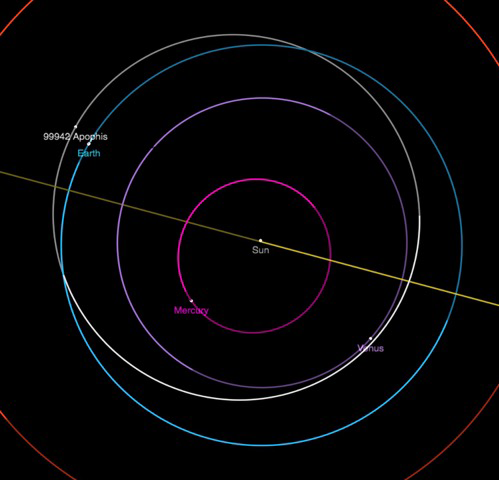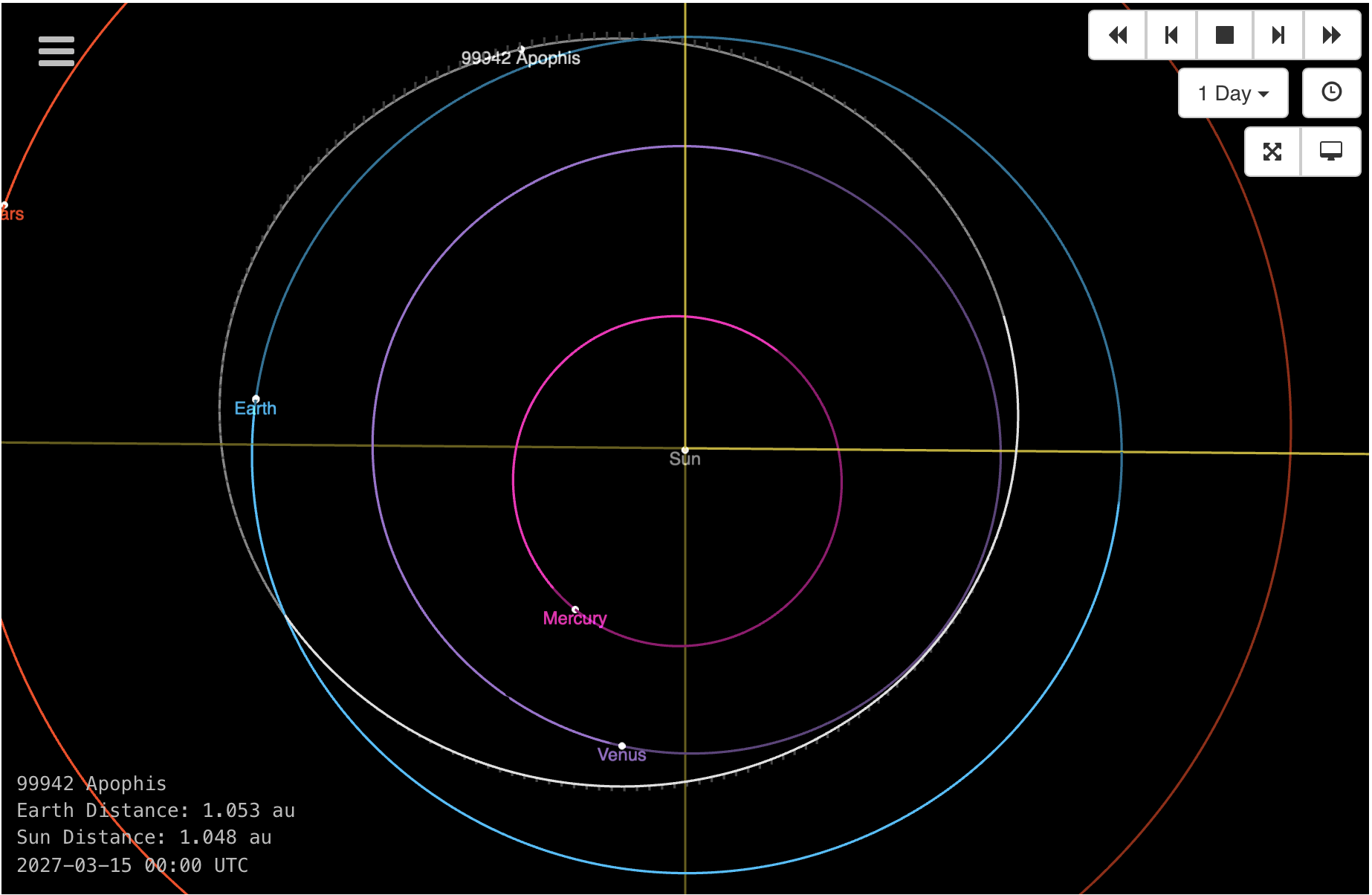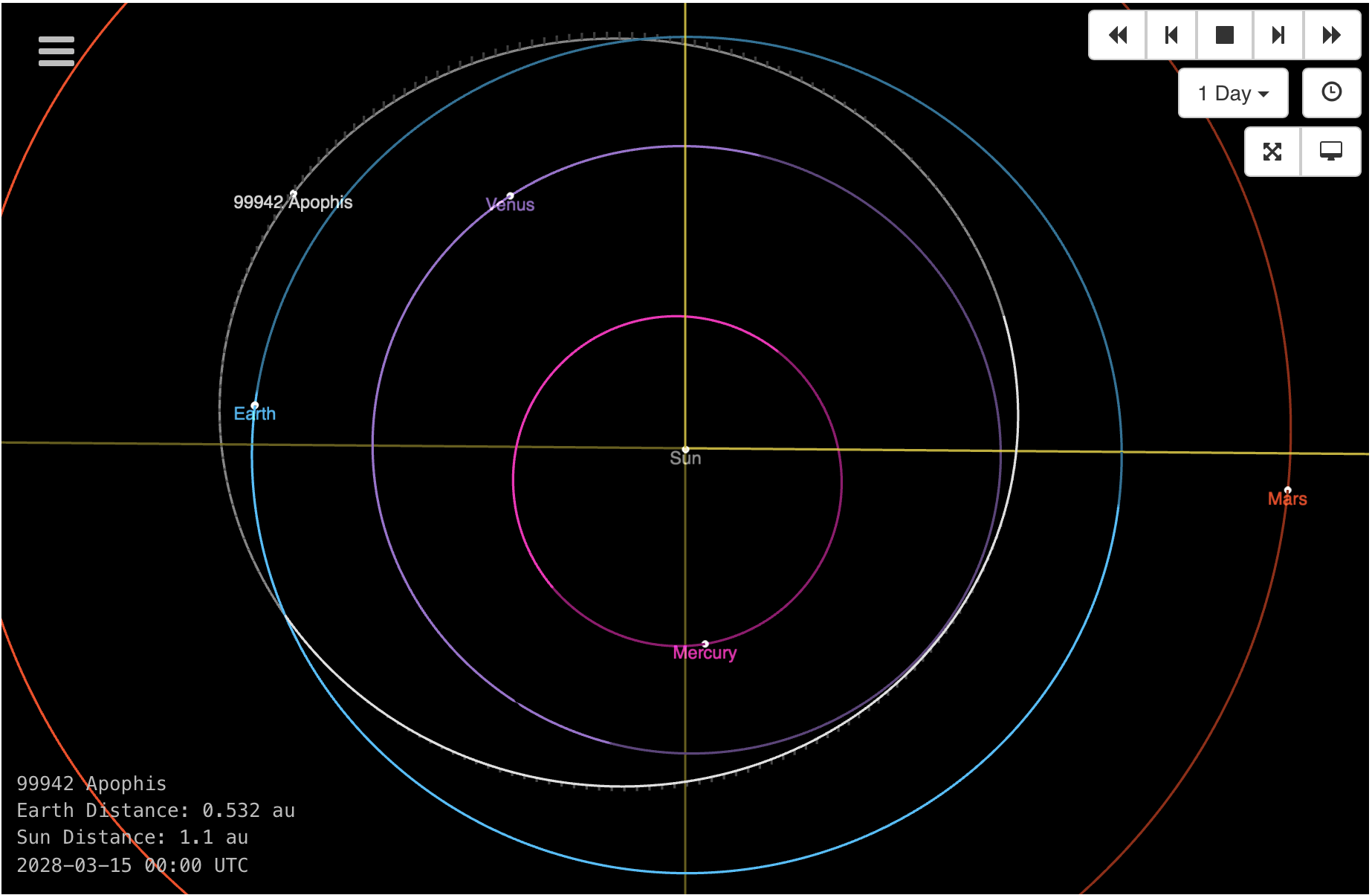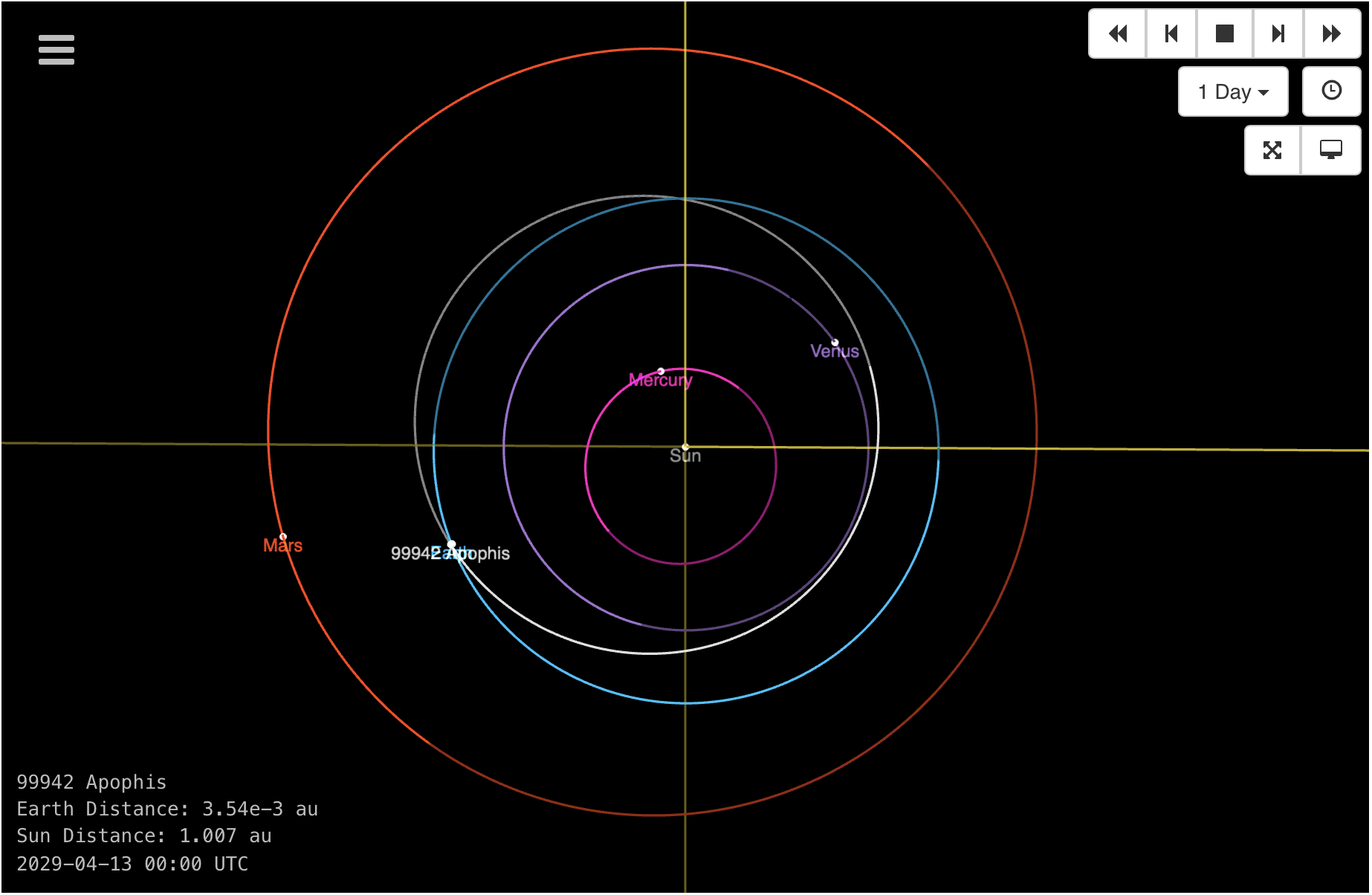2021
Orbit of Asteroid 99942 Apophis 2021
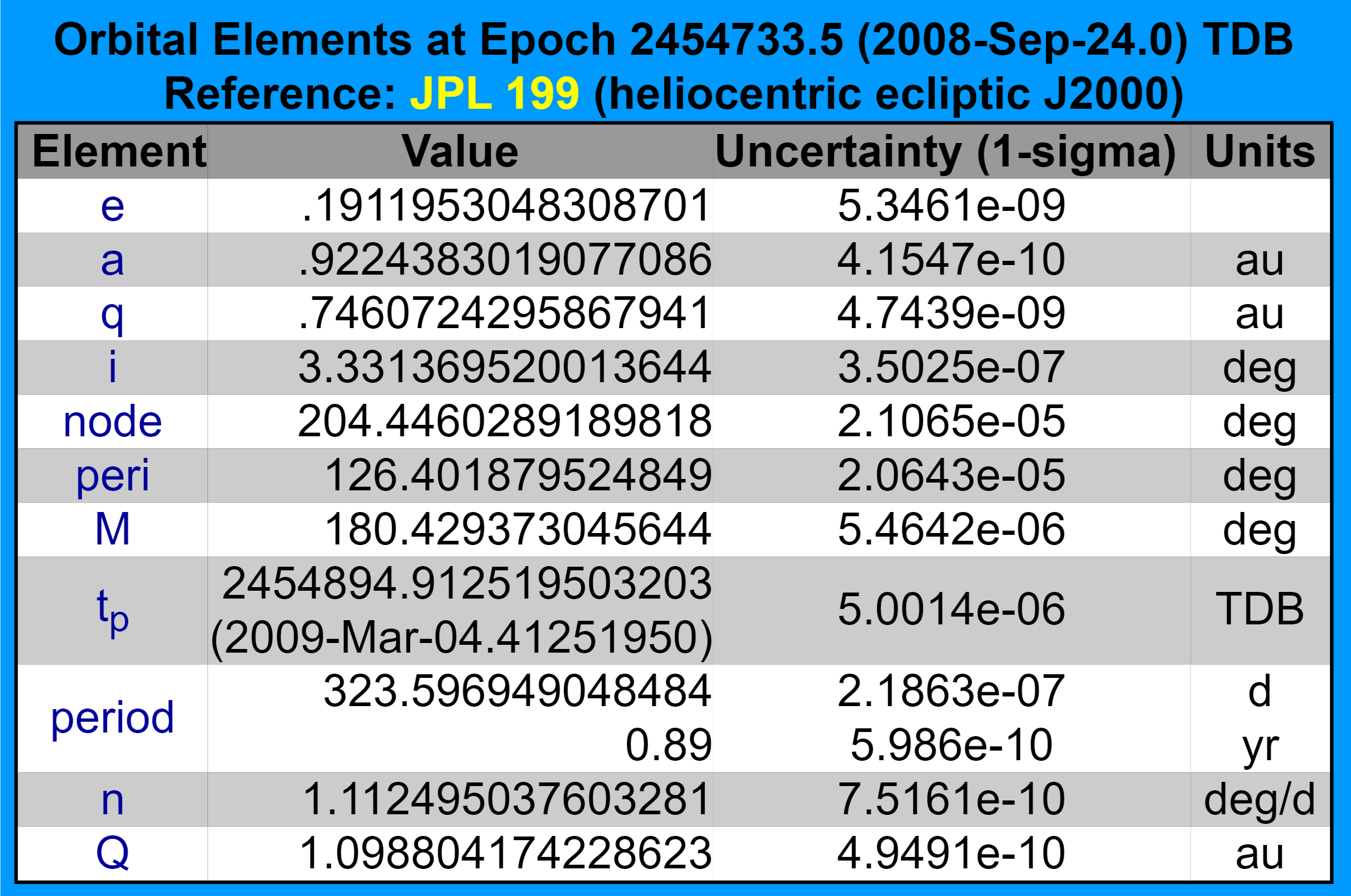 Orbital elements listed here are taken from the JPL Horizons website, and represent the current best solution. The orbit will only be perturbed slightly during the close approach to the Earth, but we still provide the Keplerian elements for both the pre- and post-Earth encounter.
Orbital elements listed here are taken from the JPL Horizons website, and represent the current best solution. The orbit will only be perturbed slightly during the close approach to the Earth, but we still provide the Keplerian elements for both the pre- and post-Earth encounter.
Orbital Elements (Solution JPL#199)
| Epoch | 2459279.54166 2021-Mar-06.0 | |
| Perihelion Time | T = 2021-Jul-29 02:26:34 UT | |
| Perihelion Time (JD) | T = 2459424.601782 | |
| Orbital Period | P = 0.8859 yr | |
| Semi-major Axis | a = 0.9224 au | |
| Perihelion Distance | q = 0.7457 AU | |
| Eccentricity | e = 0.1916 | |
| Inclination (J2000) | i = 3.34° | |
| Ascending Node (J2000) | Ω = 203.99° | |
| Argument of Perihelion (J2000) | ω = 126.66° | |
| Perigee Time | t = 2021-Mar-06 01:06 UT | |
| Perigee Distance | Δ = 0.1126 AU
Δ = 1.685×107 km |
|
| Velocity with respect to Earth at closest approach |
4.658 km/s | |
| Min. Orbital Intersection Dist. | MOID = 0.0003156 AU | |
Full Orbit From Above
View of Asteroid 99942 Apophis 2021's pre-encounter orbit as seen from the North ecliptic pole with the asteroid and planets shown at the time of the asteroid's closest approach to Earth. From the JPL Small-Body Database Browser.
Orbit in Oblique View
Oblique view of the portion of Asteroid 99942 Apophis 2021's orbit around perigee, viewed from 30° above the ecliptic plane. The black dot denotes the asteroid's and Earth's positions at perigee (2019-May-25).

PDF Version
Orbit in Earth Co-Orbital View
The orbit of Asteroid 99942 Apophis 2021 around perihelion, in the Earth's co-orbital reference frame, as seen from above (top panel) and in the ecliptic plane (bottom panel). The black circle denotes the asteroid's position at perihelion (2019-Mar-22) and the open circles show positions at 30-day intervals.
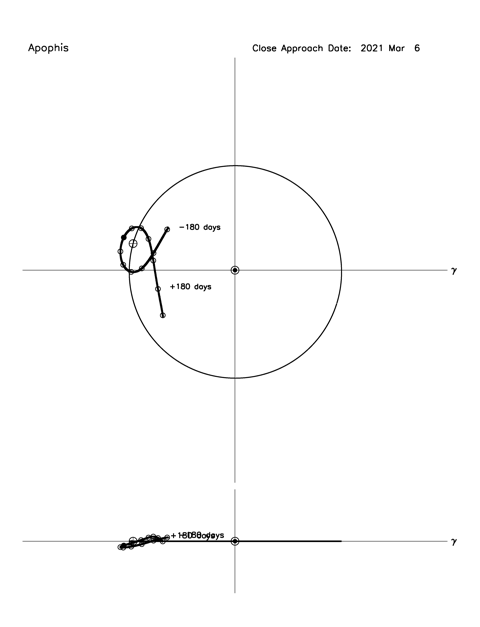
PDF Version
2027
Orbit of Asteroid 99942 Apophis 2027
 Orbital elements listed below are taken from the JPL Horizons website, and represent the current best solution. The orbit will only be perturbed slightly during the close approach to the Earth, but we still provide the Keplerian elements for both the pre- and post-Earth encounter.
Orbital elements listed below are taken from the JPL Horizons website, and represent the current best solution. The orbit will only be perturbed slightly during the close approach to the Earth, but we still provide the Keplerian elements for both the pre- and post-Earth encounter.
Orbital Elements (Solution JPL#218)
| Epoch | 2460600.5 2024-Oct-17.0 | |
| Perihelion Time | T = 2025-Feb-12.85355952 TDB | |
| Perihelion Time (JD) | T = 2460719.353559523448 | |
| Orbital Period | P = 0.88588 yr | |
| Semi-major Axis | a = 0.92238 au | |
| Perihelion Distance | q = 0.74607 AU | |
| Eccentricity | e = 0.19115 | |
| Inclination (J2000) | i = 3.34° | |
| Ascending Node (J2000) | Ω = 203.904° | |
| Argument of Perihelion (J2000) | ω = 126.672° | |
| Perigee Time | t = ?? | |
| Perigee Distance | Δ = ?? AU
Δ = ??×107 km |
|
| Velocity with respect to Earth at closest approach |
?? km/s | |
| Min. Orbital Intersection Dist. | MOID = 0.?? AU |
Full Orbit From Above
View of Asteroid 99942 Apophis 2027's pre-encounter orbit as seen from the North ecliptic pole with the asteroid and planets shown at the time of the asteroid's closest approach to Earth. From the JPL Small-Body Database Browser.
Orbit in Oblique View
Oblique view of the portion of Asteroid 99942 Apophis 2027's orbit around perigee, viewed from 30° above the ecliptic plane. The black dot denotes the asteroid's and Earth's positions at perigee (YYYY-Mon-DD).
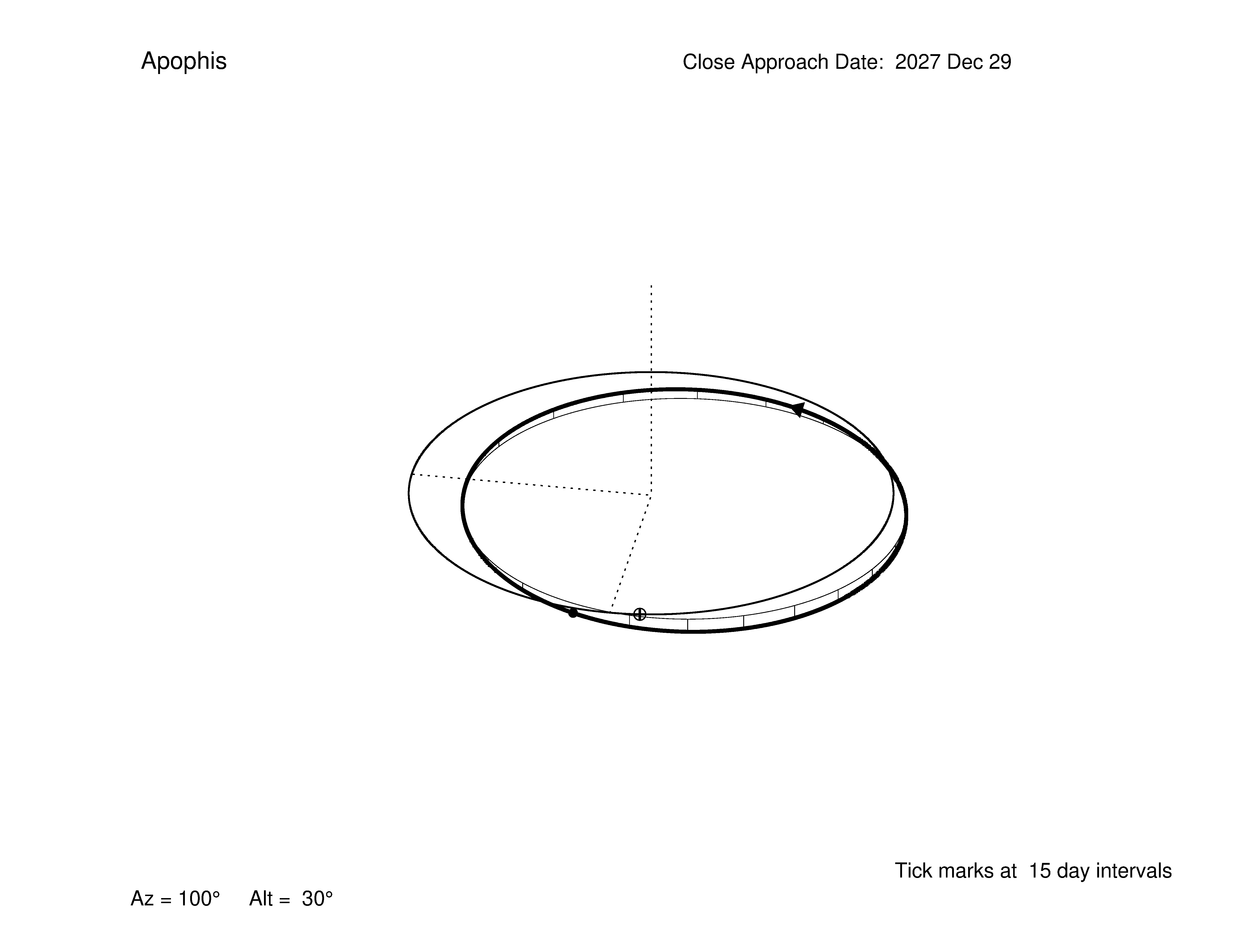
PDF Version
Orbit in Earth Co-Orbital View
The orbit of Asteroid 99942 Apophis 2027 around perihelion, in the Earth's co-orbital reference frame, as seen from above (top panel) and in the ecliptic plane (bottom panel). The black circle denotes the asteroid's position at perihelion (YYYY-Mon-DD) and the open circles show positions at 30-day intervals.

PDF Version
2028
Orbit of Asteroid 99942 Apophis 2028
 Orbital elements listed below are taken from the JPL Horizons website, and represent the current best solution. The orbit will only be perturbed slightly during the close approach to the Earth, but we still provide the Keplerian elements for both the pre- and post-Earth encounter.
Orbital elements listed below are taken from the JPL Horizons website, and represent the current best solution. The orbit will only be perturbed slightly during the close approach to the Earth, but we still provide the Keplerian elements for both the pre- and post-Earth encounter.
Orbital Elements (Solution JPL#218)
| Epoch | 2460600.5 2024-Oct-17.0 | |
| Perihelion Time | T = 2025-Feb-12.85355952 TDB | |
| Perihelion Time (JD) | T = 2460719.353559523448 | |
| Orbital Period | P = 0.88588 yr | |
| Semi-major Axis | a = 0.92238 au | |
| Perihelion Distance | q = 0.74607 AU | |
| Eccentricity | e = 0.19115 | |
| Inclination (J2000) | i = 3.34° | |
| Ascending Node (J2000) | Ω = 203.904° | |
| Argument of Perihelion (J2000) | ω = 126.672° | |
| Perigee Time | t = ?? | |
| Perigee Distance | Δ = ?? AU
Δ = ??×107 km |
|
| Velocity with respect to Earth at closest approach |
?? km/s | |
| Min. Orbital Intersection Dist. | MOID = 0.?? AU |
Full Orbit From Above
View of Asteroid 99942 Apophis 2028's orbit as seen from the North ecliptic pole with the asteroid and planets shown at the time of the asteroid's closest approach to Earth. From the JPL Small-Body Database Browser.
Orbit in Oblique View
Oblique view of the portion of Asteroid 99942 Apophis 2028's orbit around perigee, viewed from 30° above the ecliptic plane. The black dot denotes the asteroid's and Earth's positions at perigee (YYYY-Mon-DD).

PDF Version
Orbit in Earth Co-Orbital View
The orbit of Asteroid 99942 Apophis 2028 around perihelion, in the Earth's co-orbital reference frame, as seen from above (top panel) and in the ecliptic plane (bottom panel). The black circle denotes the asteroid's position at perihelion (YYYY-Mon-DD) and the open circles show positions at 30-day intervals.

PDF Version
2029
Orbit of Asteroid 99942 Apophis 2029
 Orbital elements listed below are taken from the JPL Horizons website, and represent the current best solution. The orbit will only be perturbed slightly during the close approach to the Earth, but we still provide the Keplerian elements for both the pre- and post-Earth encounter.
Orbital elements listed below are taken from the JPL Horizons website, and represent the current best solution. The orbit will only be perturbed slightly during the close approach to the Earth, but we still provide the Keplerian elements for both the pre- and post-Earth encounter.
Orbital Elements (Solution JPL#218)
| Epoch | 2460600.5 2024-Oct-17.0 | |
| Perihelion Time | T = 2025-Feb-12.85355952 TDB | |
| Perihelion Time (JD) | T = 2460719.353559523448 | |
| Orbital Period | P = 0.88588 yr | |
| Semi-major Axis | a = 0.92238 au | |
| Perihelion Distance | q = 0.74607 AU | |
| Eccentricity | e = 0.19115 | |
| Inclination (J2000) | i = 3.34° | |
| Ascending Node (J2000) | Ω = 203.904° | |
| Argument of Perihelion (J2000) | ω = 126.672° | |
| Perigee Time | t = ?? | |
| Perigee Distance | Δ = ?? AU
Δ = ??×107 km |
|
| Velocity with respect to Earth at closest approach |
?? km/s | |
| Min. Orbital Intersection Dist. | MOID = 0.?? AU |
Full Orbit From Above
View of Asteroid 99942 Apophis 2029's orbit as seen from the North ecliptic pole with the asteroid and planets shown at the time of the asteroid's closest approach to Earth. From the JPL Small-Body Database Browser.
Orbit in Oblique View
Oblique view of the portion of Asteroid 99942 Apophis 2029's orbit around perigee, viewed from 30° above the ecliptic plane. The black dot denotes the asteroid's and Earth's positions at perigee (YYYY-Mon-DD).

PDF Version
Orbit in Earth Co-Orbital View
The orbit of Asteroid 99942 Apophis 2029 around perihelion, in the Earth's co-orbital reference frame, as seen from above (top panel) and in the ecliptic plane (bottom panel). The black circle denotes the asteroid's position at perihelion (YYYY-Mon-DD) and the open circles show positions at 30-day intervals.

PDF Version
